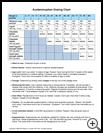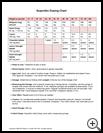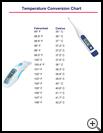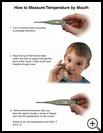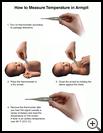
Fever
What is a fever?
A fever means the body temperature is above normal. Your child has a fever if his:
- Rectal, ear, or temporal artery temperature is over 100.4°F (38.0°C).
- Oral or pacifier temperature is over 100°F (37.8°C).
- Axillary (armpit) temperature is over 99.0°F (37.2°C).
- Ear (tympanic) temperature method is not reliable for babies under 6 months old.
Tactile (touch) fever is the impression that your child has a fever because he feels hot to the touch. Checking a fever this way is more accurate than we used to think. But if you're going to call the doctor, use a thermometer to measure the fever.
The body's average temperature when it is measured orally is 97.6°F (36.5°C). Oral temperature normally can change from a low of 95.8°F (35.5°C) in the morning to a high of 99.4°F (37.5°C) in the afternoon. Mildly increased temperature (100.4 to 101.3°F, or 38 to 38.5°C) can be caused by exercise, heavy clothing, a hot bath, or hot weather. Warm food or drink can also raise the oral temperature. If you suspect such an effect on the temperature of your child, take his temperature again in a half hour.
What is the cause?
Fever is a symptom, not a disease. It is the body's normal response to infections. Fever helps fight infections by turning on the body's immune system. Most fevers (100 to 104°F, or 37.8 to 40°C) that children get are helpful, not harmful. Most are caused by viral illnesses such as colds or the flu. Some are caused by bacterial illnesses such as Strep throat or bladder infections. Teething does not cause fever.
How long will it last?
Most fevers with viral illnesses last for 2 to 3 days. In general, the height of the fever doesn't relate to the seriousness of the illness. How sick your child acts is what counts. Fever does not cause any permanent harm. Brain damage occurs only if the body temperature is over 108°F (42°C). Fortunately, the brain's thermostat keeps untreated fevers well below this level.
While all children get fevers, only 4% develop a brief seizure from the fever. This type of seizure is generally harmless, but a child who has a febrile seizure should always be checked by a healthcare provider. If your child has had high fevers without seizures, your child is probably not going to have one.
How can I take care of my child?
- Extra fluids and less clothing
Encourage your child to drink extra fluids. Popsicles and cold drinks are helpful. Body fluids are lost during fevers because of sweating.
Clothing should be kept to a minimum because most heat is lost through the skin. Do not bundle up your child; it may cause a higher fever. During the time your child feels cold or is shivering (the chills), give him a light blanket.
If the fever is 100 to 102°F this is the only treatment needed. Fever medicines are rarely needed. Fevers of this level don’t cause discomfort, but they do help the body fight the infection.
- Medicines to reduce fever
Remember that fever is helping your child fight the infection. Fevers only need to be treated with medicine if they cause discomfort. That usually means fevers above 102°F (39°C).
These medicines start working in about 30 minutes, and 2 hours after they are given, these drugs will reduce the fever 2°F to 3°F (1°C to 1.5°C). Medicines do not bring the temperature down to normal unless the temperature was not very high before the medicine was given. Repeated dosages of the drugs will be necessary because the fever will go up and down until the illness runs its course. If your child is sleeping, don't awaken him for medicines.
Acetaminophen: Children older than 3 months of age can be given acetaminophen (Tylenol). Give the correct dosage for your child's weight every 4 to 6 hours. Never give more than 5 doses in any 24 hours.
Ibuprofen: Ibuprofen (Advil, Motrin) is approved for infants over 6 months of age. One advantage ibuprofen has over acetaminophen is a longer lasting effect (6 to 8 hours instead of 4 to 6 hours). Give the correct dosage for your child's weight every 6 to 8 hours.
CAUTION: The dropper that comes with one product should not be used with other brands.
Caution: Do not use acetaminophen and ibuprofen together unless recommended by your child’s healthcare provider. Mainly, it’s unnecessary and can be confusing.
Avoid aspirin: Doctors recommend that children (through age 21 years) not take aspirin for fevers. Aspirin taken during a viral infection, such as chickenpox or flu, has been linked to a severe illness called Reye's syndrome. If you have teens, warn them to avoid aspirin.
- Sponging
Sponging is usually not necessary to reduce fever. Never sponge your child without giving him acetaminophen or ibuprofen first. Sponge your child only if the fever is over 104°F (40°C), and hasn’t come down when you take the temperature again 30 minutes after your child has taken acetaminophen or ibuprofen.
If you do sponge your child, sponge him in lukewarm water (85 to 90°F, or 29 to 32°C). Sponging works much faster than immersion, so sit your child in 2 inches of water and keep wetting the skin surface. Cooling comes from evaporation of water. If your child shivers, raise the water temperature or stop sponging until the acetaminophen or ibuprofen takes effect. Don't expect to get the temperature down below 101°F (38.3°C). Don't add rubbing alcohol to the water; it can be breathed in and cause a coma.
When should I call my child's healthcare provider?
Call IMMEDIATELY if:
- Your child is less than 3 months old and has a fever.
- The fever is over 104°F (40°C) and has not improved 2 hours after giving fever medicine.
- Your child looks or acts very sick.
- Your child has any serious symptoms, such as fever along with severe headache, confusion, stiff neck, trouble breathing, rash, or refusing to drink.
- Your child has a fever and recent travel outside the country to high risk area.
Call within 24 hours if:
- Your child is 3 to 6 months old (unless the fever is due to an immunization shot).
- Your child has had a fever more than 24 hours without an obvious cause or location of infection AND your child is less than 2 years old.
- Your child has had a fever for more than 3 days.
- The fever went away for over 24 hours and then returned.
- You have other concerns or questions.
Last modified: 2016-06-01
Last reviewed: 2017-06-05

